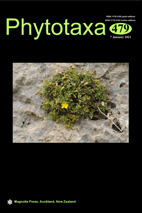Abstract
Three strains of Nostoc-related morphotypes isolated from Geum River, Korea. They were studied based on a polyphasic approach using morphology, ecological and molecular data. Phylogenetic analysis of 16S rRNA gene revealed that the selected eight genera were clearly separated into each taxonomic group, and in them, Korean strains formed a clade with Aliinostoc spp. The Aliinostoc sensu lato were monophyletic but divided two distinct lineages with high genetic distance between them (4.2% p-distance between clades vs. 1.8% within clades). In accordance with the statistical analysis, the Korean strain-belonging clade was significantly divergent to segregate from other Aliinostoc clades compared to those of the relative genera (2.8% p-distance between sister-genera vs. 0.9% within the same genus). In addition, the ITS rDNA sequence of the Korean strains showed unique characteristics in terms of nucleotide compositions and length in comparison to that of the Aliinostoc, including their secondary structures of D1–D1ʹ and Box-B. These results supported the establishment of a new genus, proposing Pseudoaliinostoc gen. nov. with a description of P. sejongens sp. nov. for the Korean strains. Likewise, three previously described Aliinostoc species were proposed to be transferred to P. soli comb. nov., P. tiwarii comb. nov., and P. constrictum comb. nov.

